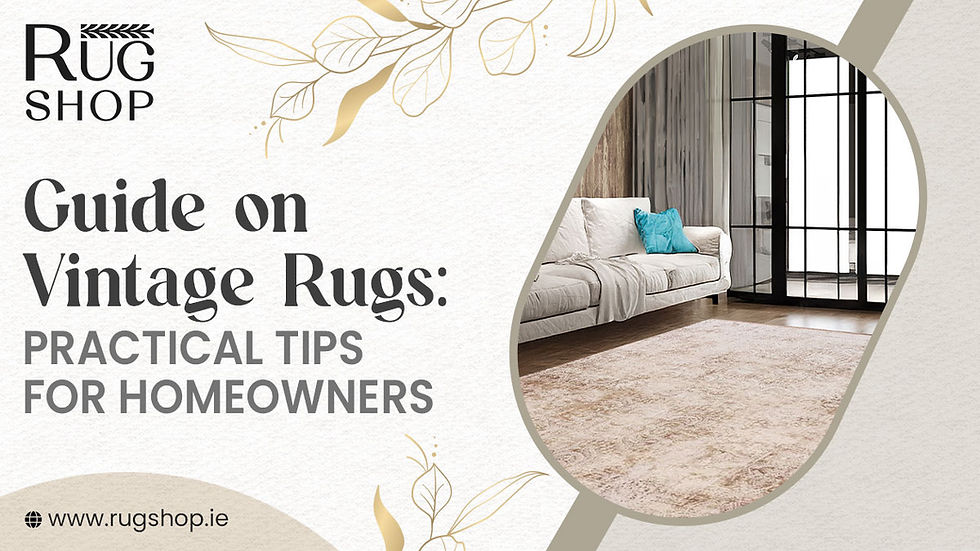Layering Rugs Like a Pro: When One Large Rug Isn’t Enough
- Dylan Holland

- Jun 5
- 4 min read
If you thought a single rug was all it took to complete a room, think again. Layering rugs is one of the hottest interior design trends right now – and for good reason. It adds texture, dimension, and personality to any space, turning a plain room into something out of a glossy home magazine. Whether you're working with a minimal Scandinavian aesthetic or a boho-chic vibe, knowing how to layer rugs like a pro can truly elevate your home. And yes, sometimes, one large rug simply isn’t enough.
Why Layer Rugs?
Layering rugs isn’t just about style; it’s also about function. It allows you to define zones in an open-plan space, add warmth to cold floors, and play with colours and patterns without making permanent changes. In fact, according to a 2024 interior trends report by Houzz, over 34% of homeowners use multiple rugs in living areas to create visual interest and cosiness.
Large rugs serve as the base for this stylish technique. They anchor your layout and provide a cohesive foundation. But the magic really happens when you add contrasting or complementary pieces on top – think smaller vintage rugs, sheepskins, or bold patterned runners.
When One Large Rug Isn’t Enough
A single large rug can often look flat or overly uniform, especially in bigger rooms. If you're dealing with a large living room, open-plan kitchen, or a multi-functional space, a lone rug might not do justice. This is where layering comes in.
Layering breaks up the monotony, introduces rich textures, and brings a bespoke flair that can’t be matched. It’s a smart strategy when you have furniture floating in the middle of a room or when you want to visually separate areas – like a reading nook or a home office – without erecting walls.
According to a recent survey by Ideal Home, 72% of UK homeowners feel that rug layering makes their home feel “more designed” and “intentionally styled”. The technique isn’t just for aesthetics either – if you have a well-used space, layering adds an extra bit of durability, with high-traffic zones protected by smaller, easily replaceable top rugs.
Texture, Texture, Texture
One of the best reasons to layer rugs is to play with textures. Start with a neutral-toned large rug – something in jute, cotton, or wool. Then layer on a contrasting texture, like a plush sheepskin, a thick shaggy rug, or a Moroccan-style piece. The mix not only feels good underfoot but also adds serious visual appeal.
Think of it like fashion: you wouldn’t wear the same fabric head to toe. Likewise, in interiors, contrasting textures make things more dynamic and inviting. Want to make a bold statement? Add a hide rug over a large flatweave. Prefer a more subtle finish? Layer a tonal patterned rug over a plain, oversized base.
Colour and Pattern Play
Layering also gives you the freedom to experiment with colours and patterns in a way that a single rug can’t. Your base rug should be relatively neutral or solid-toned – typically something that won’t clash with your upper layer. Then, add a rug with a bit more character on top. Stripes, tribal prints, florals, or abstract designs can all work brilliantly, depending on your style.
This technique is also ideal if you're working with seasonal decor. Want to warm up your space in winter? Add a jewel-toned wool rug over your existing piece. Looking to freshen things up for spring? A pastel flatweave or a breezy cotton rug layered on top can completely transform the feel.
Here’s when layering makes the most sense:
In open-plan spaces: Large rugs help define the area, while layered smaller rugs carve out purposeful corners for dining, lounging, or working.
In awkwardly shaped rooms: Layering lets you work around the space’s quirks, using shape and placement to your advantage.
Tips to Nail the Look
Layering may look effortless on Pinterest, but there’s an art to doing it well. Here’s how to keep it stylish and not chaotic:
First, stick to a cohesive colour palette. This doesn’t mean everything has to match – just that the tones and patterns should complement each other. If your large rug is neutral, you’ve got free rein with the top layer.
Second, consider scale. A tiny rug over a massive one can look like an afterthought. Aim for a top rug that’s at least 1/3 the size of the bottom rug. And make sure it’s positioned with purpose – under a coffee table, beside a bed, or layered diagonally for a more eclectic look.
Lastly, don’t be afraid to break the rules. Some of the most stylish rooms break the symmetry, using angled placements or mixing unexpected materials like cowhide with traditional Persian styles. That’s the beauty of layering – it invites creativity.
The Final Word: Don’t Settle for Just One
In a world where design is increasingly personal, layering large rugs is a bold move that shows intention, taste, and a keen sense of style. It’s about more than just filling floor space – it’s about telling a story, setting a mood, and turning your home into a curated sanctuary.
At Rugshop, we offer a hand-picked selection of large rugs perfect for layering, whether you're going for modern minimalism, rustic comfort, or artistic flair. With so many textures, colours, and patterns to choose from, the possibilities are as endless as your imagination. So next time you’re styling your space, remember: when it comes to rugs, more really can be more. Layer up and let your floor do the talking.





Comments